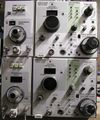7L13
The Tektronix 7L13 is a 1 kHz to 1.8 GHz Spectrum Analyzer plug-in for 7000-series scopes, designed by Fred Telewski who also led the TR502 development.
From 1977 on, a modified version with coverage up to 2.5 GHz was available upon request (no official option listed in the catalog).
The 7L13 is similar to the 7L12 but occupies three module bays, adds a marker function, offers resolution bandwidth down to 30 Hz, and improves sensitivity by 10 dB. It also displays the center frequency in the CRT readout as well as on a LED display.
When used in a four-compartment 7000 series mainframe, it must occupy the two vertical slots and the left horizontal slot.
The TR502 tracking generator is designed to work with the 7L13 up to 1.8 GHz.
After 1982, the 7L13 was superseded by the similar 7L14 which added digital storage.
Key Specifications
| Input frequency | 100 kHz – 1.8 GHz (modified version up to 2.5 GHz) |
|---|---|
| Span | 200 Hz/Div – 100 MHz/Div |
| Sweep | 1 μs/Div to 10 s/Div (1−2−5), manual, external |
| Resolution bandwidth | 30 Hz – 3 MHz in decade steps |
| Sensitivity | −128 dBm at 300 Hz to −80 dBm at 3 MHz |
| Vertical scale | 10 dB/Div, 2 dB/Div or linear |
| Reference level | −110 dBm – +30 dBm in 10 dB steps |
| Video filters | 30 kHz, 300 Hz or 10 Hz |
| Features |
|
Links
Documents Referencing 7L13
| Document | Class | Title | Authors | Year | Links |
|---|---|---|---|---|---|
| Tekscope 1974 V6 N1.pdf | Article | 30 Hz resolution at gigahertz frequencies - a new direction in spectrum analysis | Fred Telewski | 1974 | 7L13 |
| Tekscope 1975 V7 N5.pdf | Article | A High-stability 100 KHz to 1.8 GHz Tracking Generator | Fred Telewski | 1975 | TR501 • TR502 • 7L12 • 7L13 |
| TekWeek (partial) October 10, 1975.pdf | Article | Spectrum analyzers require high technology | Thor Hallen • Dave Friedley | 1975 | Spectrum Analyzers • Pentrix • 7L5 • 5L4 • 7L12 • 7L13 • 1401 • 491 • 1405 • 1502 • 1503 |
| AX-3535.pdf | Application Note | Crystal Device Measurements Using the Spectrum Analyzer | Morris Engelson | 1977 | 7L5 • 7L13 • TR502 |
Prices
| Year | 1974 | 1976 | 1980 |
|---|---|---|---|
| Catalog price | $6,500 | $7,500 | $10,500 |
| In 2023 Dollars | $40,100 | $40,100 | $38,800 |
In TekWeek 10 Oct 1975, Thor Hallen says
The 7L13 is a 3-wide plug-in and is the most expensive plug-in we make. The price is $7,500.
According to an internal memo, in 1979 annual sales were estimated at 537 units.
Internals
The input signal passes a 0 to 60 dB step attenuator, a 1.8 GHz low-pass filter, and a 3 dB isolation pad before the 1st mixer, with a 1st LO frequency between 2.095 GHz and 3.895 GHz. At spans of 50 kHz/Div and below, the 1st LO (a YIG oscillator) is fixed (stabilized by a PLL) and the 2nd LO is swept.
The 1st IF filter is 10 MHz wide, centered at 2.095 GHz. With a 2nd LO at 2.2 GHz, the signal is mixed to a 105 MHz IF, amplified, filtered again (105±1.5 MHz) and mixed down to 10 MHz (3rd LO at 95 MHz).
At the 10 MHz 3rd IF, resolution filters (300 kHz L/C, 30 kHz, 3 kHz or 300 Hz crystal filters) can be selected. The detector (discrete log amplifier) and video filters follow.
The digital frequency readout is a DVM (Fairchild 3814) working off the the YIG oscillator control voltage, not a frequency counter, which is why it needs to be calibrated before use.
Custom integrated circuits used: 155-0035-00 quad opamp, 155-0042-02 Miller integrator, 155-0056-00 sweep control, 155-0088-00 legend generator.













